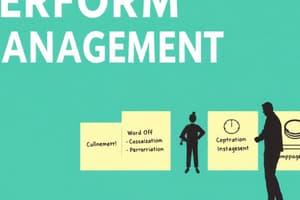Podcast
Questions and Answers
Organizations are defined by people working independently towards individual goals.
Organizations are defined by people working independently towards individual goals.
False (B)
A goal represents a past condition that the organization seeks to maintain.
A goal represents a past condition that the organization seeks to maintain.
False (B)
Management involves using organizational resources exclusively to minimize costs.
Management involves using organizational resources exclusively to minimize costs.
False (B)
The four principal managerial functions are: planning, strategizing, leading, and controlling.
The four principal managerial functions are: planning, strategizing, leading, and controlling.
Organizational assets only include tangible items like machinery and raw materials.
Organizational assets only include tangible items like machinery and raw materials.
Managers are solely responsible for dictating the use of organizational resources without team input.
Managers are solely responsible for dictating the use of organizational resources without team input.
Campbell Soup, as mentioned, focuses exclusively on cost reduction, disregarding customer quality.
Campbell Soup, as mentioned, focuses exclusively on cost reduction, disregarding customer quality.
Organizational performance exclusively focuses on achieving high sales figures, regardless of other factors.
Organizational performance exclusively focuses on achieving high sales figures, regardless of other factors.
Efficiency refers to the appropriateness of the goals chosen for the organization.
Efficiency refers to the appropriateness of the goals chosen for the organization.
Henri Fayol only described the management functions relevant to not-for-profit organizations.
Henri Fayol only described the management functions relevant to not-for-profit organizations.
Planning solely involves determining how resources should be allocated, nothing more.
Planning solely involves determining how resources should be allocated, nothing more.
Organizing solely involves creating a structure that isolates employees.
Organizing solely involves creating a structure that isolates employees.
Leading primarily focuses on micromanaging employees to ensure tasks are completed.
Leading primarily focuses on micromanaging employees to ensure tasks are completed.
Controlling mainly functions to punish employees for mistakes.
Controlling mainly functions to punish employees for mistakes.
First-line managers are responsible for setting long-term organizational goals.
First-line managers are responsible for setting long-term organizational goals.
Middle managers primarily supervise top managers and set organizational strategy.
Middle managers primarily supervise top managers and set organizational strategy.
Top managers are only responsible for overseeing their specific departments.
Top managers are only responsible for overseeing their specific departments.
Downsizing always leads to improved morale and customer satisfaction.
Downsizing always leads to improved morale and customer satisfaction.
Empowerment involves reducing workers tasks and responsibilities.
Empowerment involves reducing workers tasks and responsibilities.
In self-managed teams, supervisors are solely responsible for monitoring team members.
In self-managed teams, supervisors are solely responsible for monitoring team members.
Mintzberg's managerial roles exclusively focus on tasks performed outside the organization.
Mintzberg's managerial roles exclusively focus on tasks performed outside the organization.
The figurehead role primarily focuses on resolving internal conflicts within the organization.
The figurehead role primarily focuses on resolving internal conflicts within the organization.
The disseminator role is only responsible for transmitting information to external stakeholders.
The disseminator role is only responsible for transmitting information to external stakeholders.
The resource allocator role focuses on external negotiations exclusively.
The resource allocator role focuses on external negotiations exclusively.
Conceptual skills involve job-specific knowledge required to perform a task.
Conceptual skills involve job-specific knowledge required to perform a task.
Flashcards
Organizations
Organizations
People working together and coordinating their actions to achieve specific goals.
Goal
Goal
A desired future condition that the organization seeks to achieve.
Management
Management
The process of using organizational resources to achieve the organization's goals.
Resources
Resources
Signup and view all the flashcards
Managers
Managers
Signup and view all the flashcards
Efficiency
Efficiency
Signup and view all the flashcards
Effectiveness
Effectiveness
Signup and view all the flashcards
Planning
Planning
Signup and view all the flashcards
Organizing
Organizing
Signup and view all the flashcards
Leading
Leading
Signup and view all the flashcards
Controlling
Controlling
Signup and view all the flashcards
First-line Managers
First-line Managers
Signup and view all the flashcards
Middle Managers
Middle Managers
Signup and view all the flashcards
Top Managers
Top Managers
Signup and view all the flashcards
Downsizing
Downsizing
Signup and view all the flashcards
Empowerment
Empowerment
Signup and view all the flashcards
Self-managed teams
Self-managed teams
Signup and view all the flashcards
Managerial Role
Managerial Role
Signup and view all the flashcards
Figurehead role
Figurehead role
Signup and view all the flashcards
Leader role
Leader role
Signup and view all the flashcards
Liaison role
Liaison role
Signup and view all the flashcards
Monitor role
Monitor role
Signup and view all the flashcards
Disseminator role
Disseminator role
Signup and view all the flashcards
Spokesperson role
Spokesperson role
Signup and view all the flashcards
Entrepreneur role
Entrepreneur role
Signup and view all the flashcards
Study Notes
- Management principles cover managers and managing, and key management concepts.
- Management also includes organizational performance, functions, levels, restructuring, and skills.
Key Concepts
- Organizations involve people working together, coordinating actions to achieve goals.
- A goal is a desired future condition sought by the organization.
- Management uses organizational resources, planning, organizing, leading, and controlling to achieve goals.
- Resources include people, machinery, raw materials, information, skills, and financial capital.
- Managers supervise the use of an organization's resources to meet goals.
Achieving High Performance
- Organizations must provide goods or services customers desire.
- Examples include Campbell Soup providing quality food, healthcare providers offering healing, and McDonald's selling burgers, fries, and shakes.
Organizational Performance
- Organizational performance measures how efficiently and effectively managers use resources to satisfy customers and to achieve goals.
- Efficiency measures how well resources are used to achieve a goal and managers minimize resource input to attain the same goal.
- Effectiveness measures the appropriateness of goals chosen and the degree to which they are achieved.
- Organizations are more effective when managers choose correct goals and achieve them.
Managerial Functions
- Henri Fayol first described the four functions while CEO of a mining company in the late 1800s.
- Managers, at all levels, perform functions in for-profit and non-profit organizations.
- The four functions are:
- Planning: Choosing goals.
- Organizing: Working together.
- Leading: Coordinating.
- Controlling: Monitoring and measuring.
Planning
- Planning identifies and selects appropriate goals and actions which involves deciding:
- Which goals should be pursued.
- How the goal should be attained.
- How resources should be allocated.
- The planning function determines organization strategy, effectiveness and efficiency.
Organizing
- Organizing creates the structure of working relationships between members for the best cooperation and goal achievement.
- Managers group people into departments based on tasks and outline authority/responsibility.
- An organizational structure results from organizing, coordinating employee motivation to achieve common goals.
Leading
- Leading involves managers guiding direction, having a clear vision for employees to follow, and assisting with understanding roles in goal attainment.
- Leadership involves power, influence, vision, persuasion, and communication skills.
- The outcome of leading involves a high level of employee motivation and commitment.
Controlling
- In controlling, managers evaluate an organization's goal achievement and take corrective actions to improve performance.
- Managers monitor the organization, individuals, and departments determining if desired performance has been reached.
- Managers enhance action to increase performance as required.
- Accurate performance measurement and regulation of efficiency/effectiveness are outcomes of the controlling function.
Management Levels
- Organizations typically have three management levels:
- First-line Managers: Responsible for day-to-day operations and supervising activities for goods or services.
- Middle Managers: Supervise first-line managers, finding the best use of departmental resources to achieve goals.
- Top Managers: Responsible for all departments' performance, have cross-departmental responsibility, and establish/monitor organizational goals and middle managers.
Restructuring
- Top management has sought methods to restructure organizations and save costs
- Downsizing involves eliminating jobs at all management levels.
- Downsizing may lead to higher efficiency but can result in low morale and customer service complaints.
Management Trends
- Empowerment: Expanding worker tasks and responsibilities; supervisors may be empowered to make some resource decisions.
- Self-managed teams: Give an employee group responsibility for monitoring/supervising its own actions.
- Teams can monitor members and work quality.
Managerial Roles (Mintzberg)
- A role is a set of specific tasks a person performs based on their position.
- Roles can be directed inside and outside the organization.
- Three broad role categories:
- Interpersonal
- Informational
- Decisional
Interpersonal Roles
- Managers assume roles to coordinate and interact with employees and provide direction to the organization.
- Figurehead: Symbolizes the organization.
- Leader: Train, counsel, mentor, and encourage high performance of employees.
- Liaison: Link and coordinate people inside and outside organization.
Informational Roles
- Informational roles are associated with tasks needed to obtain and transmit information for the management of the organization.
- Monitor: Analyzes internal/external information.
- Disseminator: Transmits information to influence employee attitudes.
- Spokesperson: Uses information to positively influence others.
Decisional Roles
- Decisional roles are associated with methods managers use to plan strategy and utilize resources.
- Entrepreneur: Decides on new projects or programs for investment.
- Disturbance Handler: Assumes responsibility handling an event or crisis.
- Resource Allocator: Assigns resources, sets budgets for lower managers.
- Negotiator: Seeks solutions between managers, unions, and customers.
Managerial Skills
- Three skill sets managers need to perform effectively:
- Conceptual: Ability to analyze a situation and find cause/effect.
- Human: Ability to understand, alter, lead, and control people's behavior.
- Technical: Job-specific knowledge to perform a task (e.g., marketing, accounting, manufacturing).
- All skills are enhanced through training, reading, and practice.
Management Challenges
- Increasing number of global organizations.
- Building a competitive advantage through efficiency, quality, innovation, and responsiveness.
- Increasing performance while remaining ethical.
- Managing an increasingly diverse workforce.
- Using new technologies.
Studying That Suits You
Use AI to generate personalized quizzes and flashcards to suit your learning preferences.




